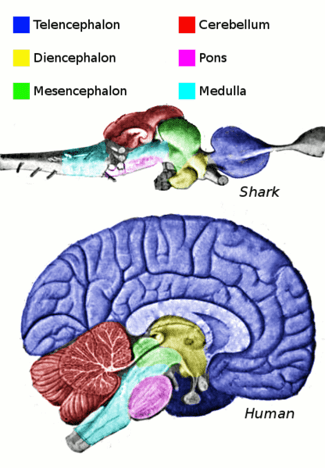Listen to Episode 121 on PodBean, YouTube, Spotify, or wherever you feel like it!
Most animals have some form of nervous system, and in many cases that nervous system is monitored and regulated by a complex and fascinating organ-in-command. This episode, we discuss the diversity, fossil record, and evolution of Brains.
In the news
First known fossil turtle embryo inside an egg
Eocene frog-legged leaf beetle named for Sir David Attenborough
Earliest known cousin of lizard and snake ancestors
Unexpected diversity in tyrannosaur braincases
A World Full of Brains
Most animals have some form of a nervous system, a network of cells that transmit signals throughout the body to coordinate actions and reactions. In many animals, this nervous system is monitored and regulated by a command center located in the head: a brain. In our bodies, the brain and spinal cord together make up the Central Nervous System.

Left: Image by BruceBlaus, CC BY-SA 4.0
Right: Image by NEUROtiker, CC BY-SA 3.0
We humans are very proud of our brains. They’re exceptionally large, comprising about 2% of our body weight on average. The various regions of our brains – the brainstem, where the brain connects to the spinal cord; the cerebellum, located just above the brainstem; the cerebrum, which makes up most of our brain-space; and all the rest – work together to produce our instincts, memories, thoughts, emotions, second-to-second regulatory processes, and nearly all the other things that make us … us.
But brains come in many forms for many functions. Most vertebrates have brains with a similar structure to ours, with a forebrain, midbrain, and hindbrain. But some species, like mice and sharks, have relatively expanded brain regions devoted to interpreting smells; and birds have a region specialized for coordinating flight; and snakes and crocs tend to have relatively small brains for their body size, but still manage to accomplish everything they need. Invertebrate nervous systems can be quite alien compared to ours, with “brains” of very different shapes, and some – like sponges – hardly have any nervous system at all.

Image by Looie496, Public Domain
Brain Evolution
Of all the soft and squishy parts of our bodies, brains are among the softest and squishiest, so they are predictably rare in the fossil record. There are, amazingly, reports of preserved brain tissue, including the simple brain of a Cambrian arthropod-cousin called Kerygmachela, the brain tissue of a fossil horseshoe crab from Mazon Creek, and even possible mineralized remains of dinosaur brain tissue. But most of the time paleontologists are studying ancient brains, they’re doing so by examining the shape of the braincase – the part of the skull that contains the brain – to interpret the shape of the brain itself. This kind of study can reveal all sorts of information about the behaviors, lifestyles, and evolution of everything from dinosaurs to our own hominin ancestors.

Left: Endocast of the sauropod dinosaur Ampelosaurus. Abbreviations listed here.
Image by Knoll et al 2013, CC BY 2.5
Right: Endocast of the pterosaur Allkaruen. Abbreviations listed here.
Image by Codorniú et al, 2016, CC BY 4.0
Combining fossil evidence and the diversity of life on Earth today, we can put together a picture of how brains might have come to be. Even single-celled organisms have methods of electrical and chemical signalling that use the same principles as our own nervous systems; somewhat more complex are the simple nervous system networks of jellyfish, called “nerve nets;” and many simple animals (including lots of wormy things) have specialized clusters of nerve cells that might represent precursors to true brains. We vertebrates are defined in part by our nervous system: a brain in our head connected to a nerve chord that runs down our backs.

Image by Looie496, Public Domain
Of course, lots of research has explored how we humans developed our very impressive brains (if we do say so ourselves). Increasing brain size is a trend we see over the course of human evolution (a general trend we also tend to see more broadly across mammals and birds), and various hypotheses have linked these expanding brains as cause and/or effect of changes in our diet, lifestyle, and culture. But brain history is complicated, and in fact our brains seem to have spent the last several thousand years getting smaller!
Feed Your Own Brain – Learn more!
A brief history of the brain – origins and evolution
The evolution of modern human brain shape (technical)
The origin and evolution of chordate nervous systems (technical)
Read more about the difficulties of interpreting animal intelligence and the problematic history of IQ tests
Brains are so important and often-discussed that it’s no surprise there are common misconceptions, including some of our personal favorite (or frustrating) brain myths: the so-called “reptile brain,” the supposed left-brain right-brain dichotomy, and the ridiculous idea that we “only use 10% of our brains.”
—
If you enjoyed this topic and want more like it, check out these related episodes:
- Episode 130 – Sense of Smell
- Episode 68 – Evolution of Eyes
- Episode 61 – Behavior in the Fossil Record
- Episode 52 – Sounds of the Past (Fossil Bioacoustics)
We also invite you to follow us on Twitter, Facebook, or Instagram, buy merch at our Zazzle store, join our Discord server, or consider supporting us with a one-time PayPal donation or on Patreon to get bonus recordings and other goodies!
Please feel free to contact us with comments, questions, or topic suggestions, and to rate and review us on iTunes
Awesome episode. One correction, the thalamus does not filter & relay smell like it does for the other senses, the olfactory bulb fills that role. Olfaction is a super interesting topic because of how old it is and how much it has diversified across the animal kingdom (you should do an episode on it!).
LikeLike
That’s a good idea for an episode – onto the list!
LikeLike